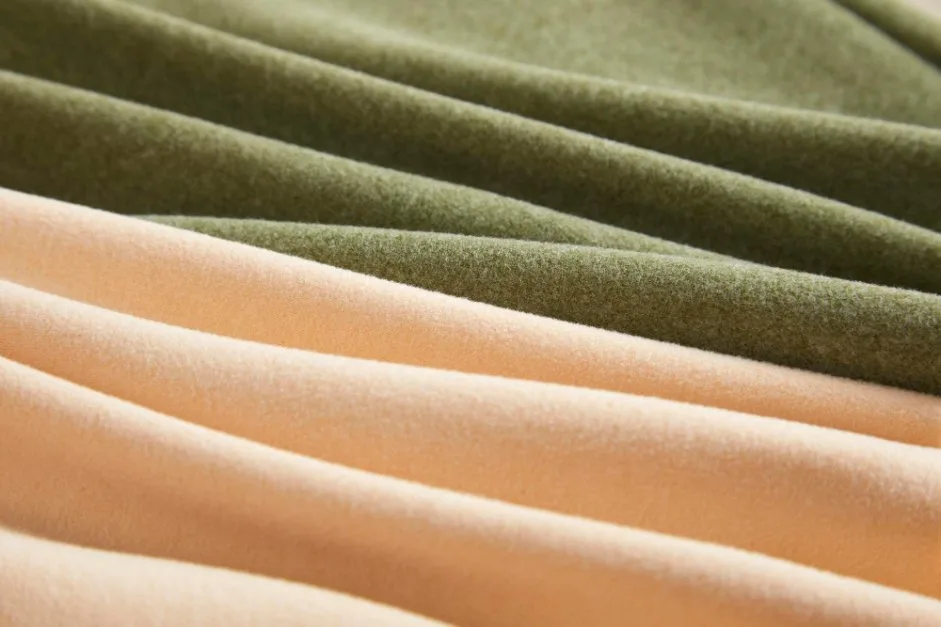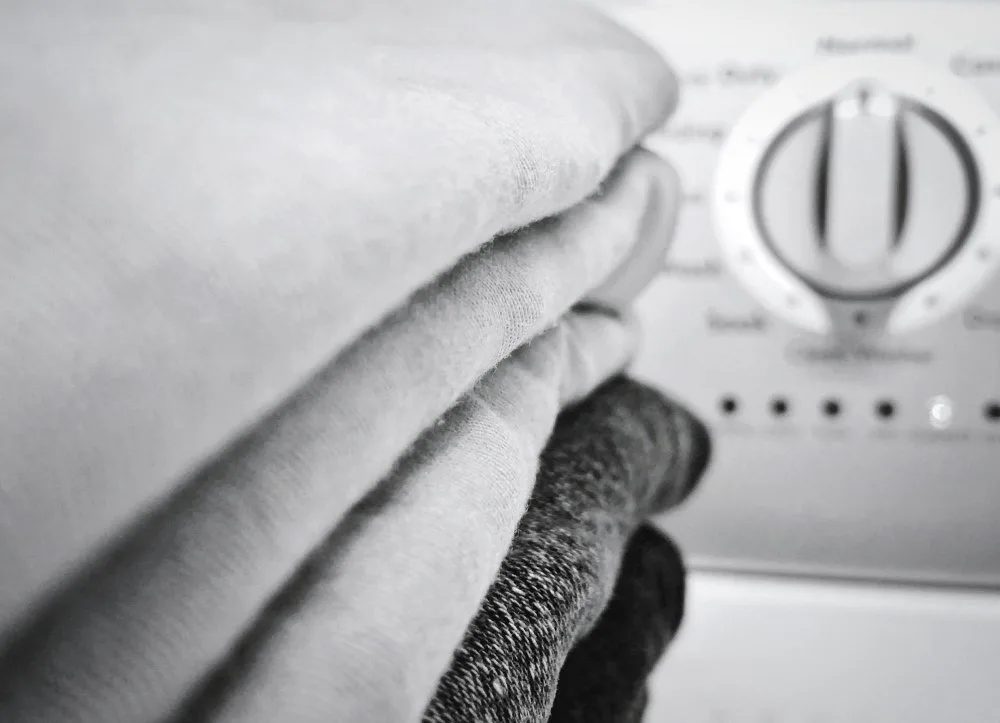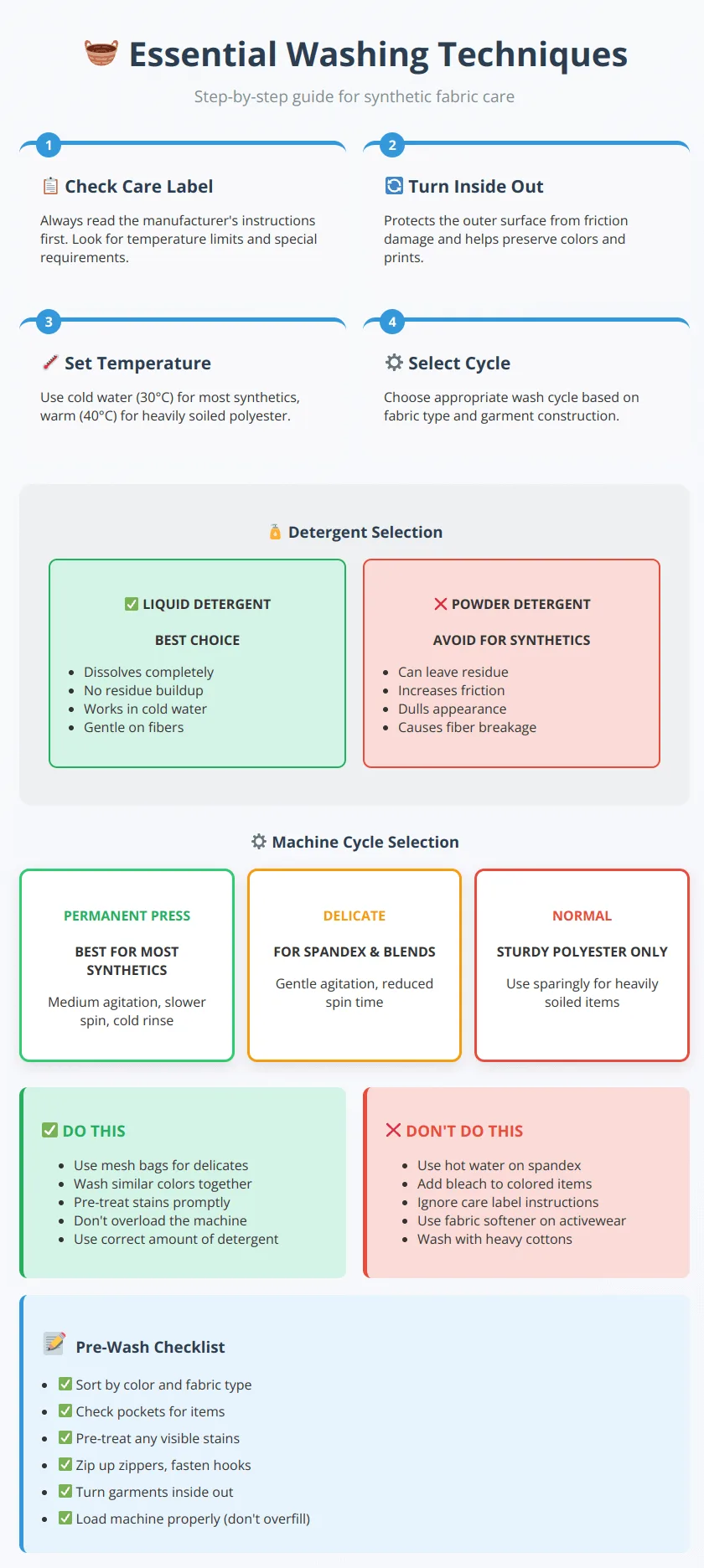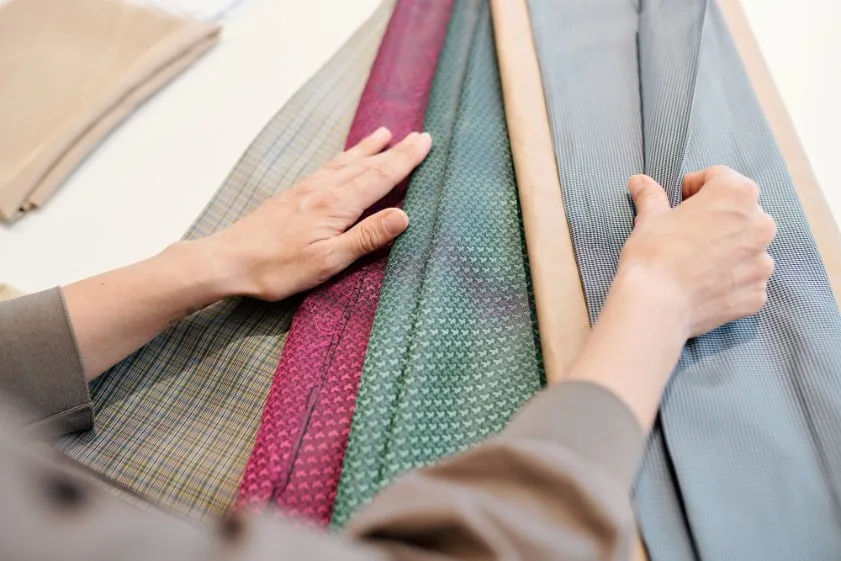Master Polyester, Nylon, and Spandex Care While Reducing Microplastic Pollution
Taking care of synthetic fabrics doesn’t have to be complicated, but it does require some specific knowledge. Whether you’re dealing with polyester, nylon, acrylic, or spandex, understanding the right care techniques will help your clothes last longer and perform better. The two most important rules: wash in cold water and avoid high heat when drying. Follow these basics, and you’ll prevent most damage to your synthetic garments.
Many people accidentally damage their synthetic clothing without realizing it. Hot water can permanently warp synthetic fibers, while fabric softeners and bleach can break down their structure over time. The good news is that synthetics are generally durable and easy to clean when you follow the right steps. Most synthetic items can be machine washed on gentle cycles, but always check the care label first.
Table of Contents
Quick Reference: Essential Synthetic Fabric Care
| Do This | Avoid This |
|---|---|
| Wash in cold water (30°C/86°F) | Hot water washing |
| Use liquid detergent | Powder detergents |
| Air dry when possible | High heat drying |
| Turn inside out before washing | Fabric softener on activewear |
| Check care labels | Ignoring manufacturer instructions |
Understanding Different Types of Synthetic Fabrics

Synthetic fabrics are created from chemical compounds and petroleum-based materials. These manufactured textiles offer unique properties that natural fabrics cannot provide, making them popular choices for specific clothing and household items. Let’s explore the main types you’ll encounter.
Polyester: The Workhorse Fabric
Polyester is one of the most common synthetic fabrics in the world. It’s known for its exceptional durability and wrinkle resistance, making it perfect for everyday clothing. You’ll find polyester in everything from business shirts to athletic wear.
This fabric retains its shape well and resists shrinking, even after multiple washes. Polyester dries quickly compared to natural fibers, which makes it ideal for activewear and outdoor clothing. When washing polyester, you can use warm water on the permanent press cycle.
Can you wash polyester at 40 degrees? Yes, polyester can handle 40°C (104°F) water without damage. In fact, this temperature works well for removing oils and everyday dirt from polyester garments.
For more detailed information about polyester care, check out our complete polyester fabric guide.
Nylon: Strong and Flexible
Nylon was one of the first synthetic fabrics developed and remains popular today. This strong material offers excellent elasticity and remarkable durability. You’ll commonly find nylon in stockings, swimwear, and activewear because it moves well with your body.
When caring for nylon, machine wash using cold water. Hot water can damage the fibers and reduce the fabric’s strength over time. Nylon does have some drawbacks – it can pill after repeated wearing and washing, and it tends to absorb odors more than other synthetics.
Acrylic: The Wool Alternative
Acrylic fabric was developed as a synthetic alternative to wool. It provides warmth without the weight or potential itchiness of traditional wool. This fabric is highly resistant to sunlight damage, making it excellent for outdoor furniture and sun-exposed clothing.
Caring for acrylic is straightforward. Machine wash in warm water and tumble dry on low heat to prevent shrinking. The fabric dries quickly and rarely needs ironing. Acrylic is also moth-resistant and hypoallergenic, making it suitable for people with wool allergies.
Spandex: The Stretch Champion
Spandex (also known as elastane or Lycra) is prized for its incredible elasticity. This fabric can stretch up to 500% of its original size and still return to its original shape. Very few garments are made from 100% spandex. Instead, small amounts (2-10%) are blended with other fibers to add stretch and flexibility.
When washing spandex-containing items, use cold water and mild detergent. Avoid bleach and fabric softeners, which can break down the elastic fibers. Heat is spandex’s enemy, so always air dry or use the lowest dryer setting to preserve the fabric’s elasticity.
The Science Behind Proper Synthetic Fabric Care
Understanding why certain care methods work helps you make better decisions. Synthetic fibers are essentially long chains of polymers created through chemical processes. Heat can break these chains or cause them to reorganize, leading to shrinkage, melting, or loss of elasticity.

As you can see, heat can break these polymer chains or cause them to reorganize, leading to permanent damage that cannot be reversed.
Do synthetic fabrics shrink when they are washed? Most synthetic fabrics are pre-shrunk during manufacturing and won’t shrink significantly with proper care. However, high heat can cause some shrinkage, especially in blends containing natural fibers.
Temperature Guidelines for Synthetic Fabrics
Here’s what happens at different temperatures:
- Cold water (30°C/86°F): Safe for all synthetics, best for preserving colors and elasticity
- Warm water (40°C/104°F): Good for polyester and nylon, helps remove oils and dirt
- Hot water (60°C/140°F): Can damage spandex and delicate synthetics, may cause shrinkage
Will a 60 degree wash shrink polyester? Pure polyester can typically handle 60°C washing without significant shrinkage, but blends containing other fibers may shrink. It’s safer to stick with 40°C unless the care label specifically allows higher temperatures.
Essential Washing Techniques for Synthetic Fabrics

Can synthetic clothes be washed? Absolutely! In fact, most synthetic fabrics are easier to care for than natural fibers. Here’s how to do it right.
Machine Washing Best Practices
Start by checking the care label on each garment. Turn your synthetic items inside out before washing to protect the outer surface from friction damage. This simple step helps preserve colors and prevent pilling.
Select the right cycle for your washing machine:
- Permanent press cycle: Best for most synthetics
- Delicate cycle: For items with spandex or delicate construction
- Normal cycle: Only for sturdy polyester items
The American Cleaning Institute recommends paying special attention to white and lightly colored synthetics, as they can pick up dark dyes from other fabrics during washing. Always wash whites separately and sort synthetic garments by color intensity to prevent color transfer
Here’s your complete step-by-step guide to washing synthetic fabrics properly:

Following these washing techniques will help preserve your synthetic garments and maintain their performance properties.
What is the best detergent for synthetic fabrics? Liquid detergents work best because they dissolve completely and rinse away more easily than powder formulations. Look for mild detergents specifically formulated for synthetic materials.
Hand Washing Methods
For delicate synthetic items, hand washing provides the gentlest care. Fill a basin with cold water and add a mild detergent. Gently swish the garment through the soapy water for 1-2 minutes without twisting or wringing.
Rinse thoroughly with cold water until all soap residue is gone. Press the fabric against the side of the basin to remove excess water rather than wringing it out.
Special Considerations for Synthetic Blends
When dealing with fabric blends, follow the care instructions for the most delicate fiber in the mix. For example, if you have a cotton-polyester-spandex blend, follow the spandex care guidelines to protect the elastic fibers.
Advanced Stain Removal and Pre-Treatment

Is synthetic fabric easy to clean? Generally, yes, but some stains require special attention. Synthetic fabrics, particularly polyester, can attract oil-based stains that become embedded in the fibers.
Identifying Common Stains on Synthetics
- Oil and grease: Appear as darkened spots that don’t rinse with water
- Sweat and deodorant: Often create yellow or white buildup
- Food stains: May combine oils, proteins, and colorants
- Makeup: Can include oils, waxes, and pigments
Pre-Treatment Strategies
Act quickly when dealing with stains. Fresh stains are much easier to remove than dried ones. Here’s your step-by-step approach:
- Blot, don’t rub any excess liquid with a clean cloth
- Rinse with cold water from the back of the stain
- Test cleaning solutions on an inconspicuous area first
- Apply pre-treatment and let it work for 15-30 minutes
For polyester garments, dishwashing soap works well as a pre-treatment for oil-based stains. Apply a small amount directly to the stain and gently work it in with your fingertips.
Different types of stains require different approaches. Here’s your comprehensive guide to tackling any stain on synthetic fabrics:

Remember, the key to successful stain removal is acting quickly and using the right technique for each type of stain.
Deep Cleaning Synthetic Clothes
How to deep clean synthetic clothes? For heavily soiled items or periodic deep cleaning:
- Soak overnight in cold water with enzyme detergent
- Use oxygen bleach (not chlorine) for white synthetics
- Add white vinegar to the rinse cycle to remove detergent buildup
- Consider professional cleaning for valuable or delicate items
What does adding baking soda to laundry do? Baking soda helps neutralize odors, soften water, and boost detergent effectiveness. Add 1/2 cup to your wash cycle for heavily soiled synthetic garments.
Drying Techniques That Preserve Fabric Quality
Proper drying is crucial for maintaining synthetic fabric performance. Heat damage during drying is one of the most common ways people accidentally ruin their synthetic clothes.
Air Drying: The Safest Method
Air drying is the best choice for all synthetic fabrics. Hang items on a clothesline or lay them flat on a drying rack. This method prevents heat damage and reduces microplastic shedding.
Benefits of air drying:
- Prevents heat damage and shrinkage
- Reduces static electricity
- Saves energy and extends fabric life
- Minimizes microplastic release
Machine Drying Guidelines
If you must use a dryer, follow these rules:
- Use low heat only (one dot on care symbols)
- Remove items promptly when slightly damp
- Don’t overload the dryer
- Add dryer balls instead of fabric softener sheets
How long does synthetic fabric last? With proper care, synthetic fabrics can last 5-10 years or more. Poor drying habits are the fastest way to shorten their lifespan.
Proper drying is crucial for maintaining synthetic fabric performance. Here’s what you need to know about safe drying methods:

Choosing the right drying method can significantly extend the life of your synthetic garments while preserving their original properties.
Understanding Fabric Care Symbols
Fabric care symbols provide essential information about how to treat your synthetic garments.
Need quick answers while doing laundry? Use our Interactive Synthetic Fabric Reference Chart to instantly find care instructions, washing temperatures, and special handling tips for any synthetic fabric.
Here’s what the most common symbols mean for synthetics:
Washing Symbols
| Symbol | Meaning | Best for Synthetics |
|---|---|---|
| Tub with 30° | Wash at 30°C max | All synthetics |
| Tub with 40° | Wash at 40°C max | Polyester, nylon |
| Tub with hand | Hand wash only | Delicate blends |
| Tub with X | Do not wash | Take to dry cleaner |
Drying Symbols
| Symbol | Meaning | Synthetic Application |
|---|---|---|
| Square with circle and 1 dot | Low heat tumble dry | Safe for most synthetics |
| Square with circle and X | No tumble drying | Spandex and delicates |
| Square with line | Line dry | Recommended for all |
For a complete guide to reading care labels, check our fabric care guide.
Health and Environmental Considerations
Recent research has raised important questions about synthetic fabric safety and environmental impact. Understanding these issues helps you make informed decisions about your wardrobe.
Health Concerns with Synthetic Fabrics
Are synthetic clothes good for skin? This depends on several factors. Some people with sensitive skin may experience irritation from synthetic materials due to:
- Reduced breathability compared to natural fibers
- Chemical treatments used in manufacturing
- Static electricity buildup
- Potential for trapping bacteria and odors
What is the safest material to wear on your body? Generally, natural fibers like organic cotton, hemp, and wool are considered safest for direct skin contact. However, modern synthetic fabrics have improved significantly, and many people wear them without issues.
When to Avoid Synthetic Fabrics
When should we not wear synthetic clothes? Consider avoiding synthetics in these situations:
- Hot, humid weather: Synthetics don’t breathe as well as natural fibers
- Intense physical activity: Can trap sweat and bacteria
- Near open flames: Synthetics are more flammable than natural fibers
- Sensitive skin conditions: May cause irritation in some people
Why do people avoid wearing synthetic clothes in summer? Synthetic fabrics often trap heat and moisture, making you feel hotter and stickier. Natural fibers like cotton and linen allow better airflow and moisture wicking.
The Microplastics Problem
Every time you wash synthetic clothes, tiny plastic fibers shed and enter waterways. According to the U.S. Environmental Protection Agency, secondary microplastics break down from larger plastic materials, including synthetic textiles, and have been found in every ecosystem on the planet
The Scale of the Problem:
- A single wash can release 700,000+ microfibers
- Synthetic textiles account for 35% of ocean microplastic pollution
- These particles are found in drinking water, food, and even human tissue
Reducing Microplastic Shedding
You can significantly reduce microplastic release with these strategies:
- Wash less frequently – Air out clothes between wears
- Use cold water – Reduces fiber breakdown
- Install washing machine filters – Capture up to 90% of microfibers
- Use microfiber-catching bags – Products like Guppyfriend bags work well
- Choose high-quality synthetics – Better construction means less shedding
Recent research has raised important questions about synthetic fabric safety and environmental impact. Here’s what the latest studies reveal:

While these impacts are concerning, understanding them helps you make informed decisions and take steps to reduce harm.
Should I get rid of all my polyester clothes? Not necessarily. The environmental impact of replacing all your clothes would likely be greater than continuing to wear what you have. Instead, focus on reducing microplastic shedding and choosing natural fibers for future purchases.
Special Care for Performance and Athletic Wear

Athletic wear made from synthetic fabrics requires specific care to maintain performance features. These garments often contain specialized blends of polyester and spandex designed for moisture-wicking and compression.
Maintaining Elasticity in Activewear
Cold water washing is essential for preserving elasticity in activewear. Hot water breaks down spandex fibers over time, causing garments to lose their shape and supportive compression.
Stay organized with our Personalized Care Schedule Generator that creates custom washing and maintenance schedules based on your wardrobe and lifestyle preferences.
Key practices for activewear:
- Turn items inside out before washing
- Use sport-specific detergents when possible
- Never use fabric softener
- Air dry whenever possible
Athletic wear requires special attention to maintain its performance features. Here’s how to care for your activewear properly:

Proper athletic wear care ensures these specialized garments continue to enhance your performance for years to come.
Removing Odors from Synthetic Athletic Wear
How to get sweat smell out of bra? Synthetic bras and athletic wear can trap odors. Try these methods:
- Pre-soak in cold water with white vinegar (1:4 ratio)
- Use enzyme detergent designed for protein stains
- Add baking soda to boost odor removal
- Sun dry when possible – UV rays help kill bacteria
For persistent odors, soak overnight in cold water with oxygen bleach (for white items) or enzyme cleaner.
Troubleshooting Common Synthetic Fabric Problems
Even with proper care, you might encounter issues with synthetic garments.
When problems arise, use our Interactive Troubleshooting Flowchart for step-by-step solutions to common synthetic fabric issues like static, pilling, odors, and stains.
Here’s how to address the most common problems:

Most synthetic fabric problems are preventable with proper care, but these solutions help when issues arise.
Static Electricity Solutions
Synthetic fabrics are prone to static buildup, especially in dry conditions. Here are effective solutions:
- Add white vinegar to the rinse cycle (1/2 cup)
- Use dryer balls instead of fabric softener sheets
- Increase humidity in your home during winter
- Lightly mist with water from a spray bottle
Pilling Prevention and Removal
Pilling occurs when short fibers work their way to the surface and tangle together. To prevent pilling:
- Wash similar fabrics together
- Turn garments inside out
- Use the gentle cycle
- Avoid overloading the washer
To remove existing pills, use a fabric shaver or carefully trim with small scissors. For more sewing and fabric care tips, visit our essential sewing supplies guide.
Color Fading and Restoration
Synthetic fabrics can fade over time, especially with frequent washing. To minimize fading:
- Wash in cold water
- Turn dark colors inside out
- Avoid direct sunlight when line drying
- Use color-protecting detergents
Professional Care and When to Seek Help
What is the hardest fabric to clean? While most synthetics are easy to care for at home, some situations require professional attention:
- Heavily stained white synthetics
- Structured garments with interfacing
- Items with special finishes or coatings
- Valuable or sentimental pieces
For items that require dry cleaning, choose a cleaner experienced with synthetic fabrics. The processes used for natural fibers may not be appropriate for synthetics.
Storage and Seasonal Care
Proper storage prevents damage during off-seasons and extends fabric life. Here’s your complete storage strategy:

Following these storage guidelines ensures your synthetic garments emerge from storage in excellent condition.
Short-Term Storage
For everyday storage:
- Ensure items are completely clean and dry
- Use breathable garment bags for delicate items
- Fold heavy synthetics to prevent stretching
- Hang lightweight items on appropriate hangers
Long-Term Seasonal Storage
When storing synthetic clothes for months:
- Clean thoroughly before storage
- Use acid-free tissue paper between folds
- Store in breathable containers, not plastic bags
- Keep away from direct sunlight and heat sources
- Check periodically for pest damage
Making Informed Purchasing Decisions
Understanding synthetic fabric care can influence your future clothing purchases. Consider these factors:
Quality Indicators
Higher-quality synthetic fabrics often:
- Have tighter weaves that shed fewer microfibers
- Include performance treatments for odor resistance
- Use better dyes that resist fading
- Feature reinforced stress points
Sustainable Alternatives
While synthetics have benefits, consider these alternatives when possible:
- Recycled synthetic fibers – Lower environmental impact
- Natural performance fabrics – Merino wool for activewear
- Innovative bio-based synthetics – Made from plant materials
- Hybrid blends – Combine natural and synthetic benefits
Frequently Asked Questions
Do you need to prewash synthetic fabric?
Unlike natural fabrics, most synthetic fabrics don’t require prewashing before use. They’re typically pre-shrunk during manufacturing. However, prewashing can remove chemical treatments and sizing agents if you have sensitive skin.
Can you wash 100% polyester in a washing machine?
Yes, 100% polyester is generally safe for machine washing. Use warm water (up to 40°C) on the permanent press cycle. Polyester is one of the most durable synthetic fabrics and handles machine washing well.
What is the difference between synthetic and polyester?
Polyester is a type of synthetic fabric. “Synthetic” is the broad category that includes polyester, nylon, acrylic, and other man-made fibers. Think of it like “fruit” (synthetic) and “apple” (polyester).
What are the disadvantages of synthetic fabrics?
Main drawbacks include:
• Reduced breathability compared to natural fibers
• Environmental impact from microplastic shedding
• Potential for static electricity and odor retention
• Less biodegradable than natural alternatives
• May feel less comfortable against skin
What happens if I wash at 40 instead of 30?
For most synthetic fabrics, washing at 40°C instead of 30°C isn’t harmful and may actually clean better. However, items with spandex or delicate construction should stick to 30°C to prevent damage.
Can I put vinegar in my washing machine?
Yes, white vinegar is safe for washing machines and beneficial for synthetic fabrics. Add 1/2 cup to the rinse cycle to remove detergent buildup, reduce static, and neutralize odors. Don’t use vinegar with bleach.
When should you not wash clothes?
Avoid washing when:
• Items aren’t actually dirty (just wrinkled or briefly worn)
• You’re dealing with certain stains that need special pre-treatment
• Care labels specify dry cleaning only
• You don’t have appropriate washing conditions (proper detergent, water temperature)
Advanced Care Techniques
Using Fabric Conditioners Wisely
While fabric softeners can make synthetics feel softer, they’re not always recommended:
Use fabric softener for:
- Basic polyester garments
- Items that feel stiff after air drying
- Reducing static in dry climates
Avoid fabric softener for:
- Athletic wear and moisture-wicking fabrics
- Items with special treatments
- Anything with spandex or elastic
- Towels and absorbent items
Ready to take your synthetic fabric care to the next level? These professional techniques deliver superior results:

Master these advanced techniques gradually – your synthetic garments will reward careful attention with years of reliable service.
Professional-Level Cleaning Additives
What are the two synthetic detergents? The main categories are:
- Anionic detergents – Common in household products, good for removing oils
- Non-ionic detergents – Gentler, often used in delicate formulations
Is Persil a good laundry detergent? Persil is considered one of the top-performing detergents for synthetic fabrics. Its enzyme formula works well on protein stains and oils commonly found on synthetic athletic wear.
Environmental Impact and Sustainable Practices
The Carbon Footprint of Synthetic Care
Your washing habits significantly impact the environment:
- Cold water washing reduces energy use by up to 90%
- Air drying eliminates dryer energy consumption
- Washing full loads maximizes efficiency
- Using eco-friendly detergents reduces chemical runoff
Your washing habits significantly impact the environment. Here’s how to minimize your synthetic fabric footprint:

Small changes in care habits can significantly reduce environmental impact while saving money and extending garment life.
Future of Synthetic Fabric Care
Emerging technologies are addressing synthetic fabric challenges:
- Enzymatic treatments that reduce microfiber shedding
- Closed-loop washing systems that capture all microplastics
- Bio-based synthetic alternatives with better end-of-life properties
- Smart fabrics that require less frequent washing
Conclusion
Caring for synthetic fabrics properly isn’t just about keeping your clothes looking good – it’s about maximizing their lifespan, maintaining their performance, and minimizing environmental impact. The key principles are simple: use cold water, avoid excessive heat, and treat different synthetic types according to their specific needs.
Remember that synthetic fabrics, while often criticized for environmental reasons, serve important functions in modern wardrobes. Athletic wear wouldn’t perform the same way without synthetic materials, and many synthetic fabrics offer durability and ease of care that natural fibers can’t match. The goal isn’t to eliminate synthetics entirely but to care for them responsibly.
Key Takeaways:
- Master the basics: Cold water washing and low-heat drying prevent most synthetic fabric damage
- Read care labels: They provide fabric-specific guidance that trumps general rules
- Address microplastics: Use washing bags, install filters, and wash less frequently when possible
- Choose quality: Better synthetic fabrics last longer and shed fewer microplastics
- Consider alternatives: Natural fibers work better for some applications, especially next-to-skin wear
Your Action Plan:
- Audit your current synthetic care routine and identify improvement areas
- Invest in a few key tools: microfiber washing bags, dryer balls, fabric shaver
- Learn to read care symbols confidently
- Consider your purchasing decisions with both performance and environmental impact in mind
- Share these practices with family members to maximize impact
By following these guidelines, you’ll not only extend the life of your synthetic garments but also reduce their environmental impact. Your clothes will look better, perform better, and you’ll save money by avoiding premature replacement. Most importantly, you’ll be part of the solution to reducing microplastic pollution while still enjoying the benefits that synthetic fabrics provide.
For a personalized reference, try our Synthetic Fabric Care Guide Generator to create custom PDF guides tailored to your specific garments and fabric types.
Whether you’re caring for everyday polyester blouses, high-performance athletic wear, or delicate synthetic blends, these principles will serve you well. Remember, good fabric care is an investment in your wardrobe, your wallet, and the environment.
For more comprehensive fabric care guidance, explore our related guides on natural fabric care and specific fabric types. Taking a holistic approach to fabric care ensures all your garments receive the attention they deserve.



